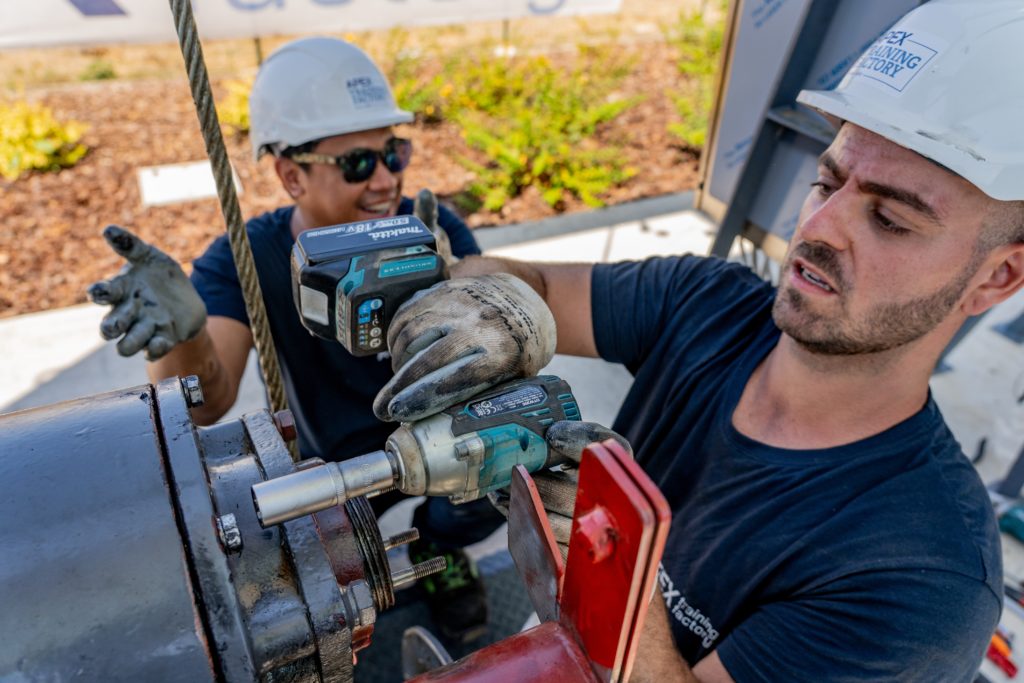SERVICE PERSONNEL – Inexperienced 1 week course
ISO part 2 – Level I (Initial) 3 modules
General
This program is designed to meet the initial training and assessment requirements for all prospective service technicians. The Initial Service Technician training explains how competence shall be assessed and certified.
Candidate prerequisites for Initial Service Technician training;
To hold or be working towards a nationally recognized qualification in engineering or mechanics, but not unduly excluding similar qualifications.
The key objectives are:
- Introduce and familiar candidates to the terminology and equipment;
- ensure candidates have an awareness of the functions and roles of the various organizations within the maritime and offshore industry, in relation to manufacturers/ASP operations;
- ensure candidates can identify the types, components, role, function, design and construction
requirements for lifeboats (including free-fall lifeboats), rescue boats and fast rescue boats, including on-load release gear and launching appliances;
- ensure candidates can identify and explain the key causes of lifeboat and rescue boat accidents;
- ensure candidates understand the roles and responsibilities of a manufacturer/ASP service technician;
- ensure candidates can identify, interpret and apply to their role key legislation, industry guidelines, rules, regulations and conventions applicable to ASP/manufacturer’s operations;
- ensure candidates can identify the procedures for maintenance thorough examination, operational testing, repair and overhaul of lifeboat (including free-fall lifeboats), rescue boats and fast rescue boats, launching appliances and on-load release gear, as applicable;
- ensure candidates can identify the requirements for reports and records;
- ensure candidates understand and can demonstrate in their working environment basic safety and awareness.
Theory learning outcomes
Module 1 — Service technician general industry knowledge;
To successfully complete the Initial Service Technician training programme, candidates shall be able to:
- Identify the organizations and regulatory bodies associated with the maritime and oil and gas industry, and their roles and functions;
- understand the legislative framework and industry guidelines applicable to manufacturers and
ASPs;
- identify and interpret the relevant rules and regulations, including international conventions related to the maintenance, thorough examination, operational testing, overhaul and repair of lifeboats and rescue boats, launching appliances and release gear;
- explain the key roles and responsibilities of a service technician;
- identify the different types of lifeboats, rescue boats, fast rescue boats and davit-launched liferafts, and explain their key roles and functions;
- identify and interpret the design and construction requirements for lifeboats (including free-fall lifeboats), rescue boats and fast rescue boats and davit-launched liferafts;
- identify the various types of launching appliances for lifeboats, rescue boats and davit-launched liferafts;
- identify the individual components that make the various types of launching appliances for lifeboats, rescue boats, fast rescue boats and davit-launched liferaft, and explain their role and how they function;
- identify the characteristics of mechanical restraints, and explain their function;
- identify the various types of on-load release gear, and interpret their design and construction requirements;
- identify the common causes of lifeboat and rescue boat accidents, and the measures to mitigate risks and to stop accidents from occurring.
- identify and interpret procedures for the inspection, maintenance, thorough examination, operational testing, overhaul and repair of lifeboats, rescue boats, launching appliances and release gear; and identify and interpret procedures for issuing a report of service and statement of fitness for purpose.
Module 2 — Basic safety at work
To successfully complete the Initial Service Technician training program candidates shall be able to:
- Identify and explain health and safety legislation in the work environment, including specific requirements whilst conducting activities on-board;
- identify diverse types and uses of PPE;
- explain the basic principles of manual handling techniques;
- explain the requirements of COSHH and its application in the workplace;
- identify typical workplace hazards, including pressure systems in lifeboats;
- explain procedures to follow and identify the equipment required for working at height;
- identify and explain relevant lifesaving rules associated with the typical workplace hazards;
- identify and explain company specific lifesaving/golden rules; and
- explain basic lifesaving appliance safety.
Module 3 — Risk management
To successfully complete the Initial Service Technician training program candidates shall be able to:
- Explain the difference between hazard, risk and control;
- explain the concepts of risk assessment and techniques used;
- explain the risk assessment process and the use of a risk matrix;
- explain how to apply control to bring the risk down to ALARP;
- identify the need for dynamic risk assessment; and
- explain the function of a risk intervention system and how to carry out an intervention.
Practical learning outcomes
Module 1 — Service technician general industry knowledge
To successfully complete the Initial ASP Service Technician training program, candidates shall be able to demonstrate:
- Ability to identify and interpret the relevant information in relation to the rules, regulations and international conventions in relation to manufacturers/ASP operations; and
- safe operation of on-load release gear.
Module 2 — Basic safety at work
To successfully complete the Initial ASP Service Technician training program, candidates shall be able to:
- demonstrate the elements of a good individual lift,
- a team lift with appropriate communications,
- and correct loading/unloading methods for using a trolley.
Module 3 — Risk management
To successfully complete the Initial ASP Service Technician training program, candidates shall be able to demonstrate how to:
- Conduct an effective risk assessment using a risk matrix;
- participate in an effective toolbox talk; and
- conduct an effective risk intervention and complete a risk intervention card.

